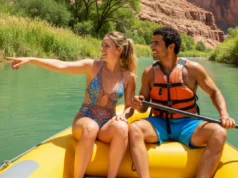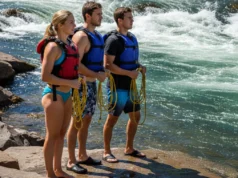In this article
Imagine a massive, almost unbelievable craft—three giant rubber tubes lashed together—powering through the heart of a Grand Canyon rapid, not with the finesse of oars, but with the brute force of an outboard motor. Now, imagine this isn’t today; it’s the 1950s. At the helm is a woman in her signature leopard-print leotard, a can of Coors in hand. This wasn’t just a spectacle; it was a revolution in whitewater rafting history. To understand the technology that democratized the world’s most iconic canyon, we must first understand the life of its brilliant and controversial architect, Georgie White Clark, a pivotal figure among pioneering women in outdoor adventure sports and the first woman commercial river runner in the Grand Canyon.
- The Catalyst of Tragedy: Learn how a devastating personal loss in 1944 reshaped Georgie’s relationship with risk and drove her to the unforgiving wilderness of the Colorado River.
- From Swimmer to Innovator: Discover her unconventional apprenticeship—swimming the river in a lifejacket with Harry Aleson—and how it directly informed her unique “brute force” design philosophy.
- The “G-Rig” Revolution: Get a technical breakdown of how she used army-surplus rafts to create the G-rig/Triple Rig, a high-capacity, high-stability platform that became the direct ancestor of modern motorized rafts.
- A Polarizing Legacy: Explore the complex and controversial aspects of her career, from her questionable safety record and media appearances on The Tonight Show Starring Johnny Carson, to her enduring industry influence on river regulation and culture.
Who Was the Woman Behind the Legend?
How did personal tragedy forge a river pioneer?
Every river guide knows that the calmest pools are often carved by the most violent floods. The same can be said for people. Georgie White Clark, often called the “Woman of the River,” wasn’t born into the wild; she was driven there. Born Bessie DeRoss in Oklahoma in 1911, she spent her early years actively constructing a new identity as “Georgie,” a first signal of a lifelong pattern of fierce self-determination. Her early life was defined by non-conformity, including a cross-country bicycle trip with her first husband, Harold Clark. Two brief marriages left her with the last names (Clark and White) that she would combine. But the defining event, the flash flood that would forever alter her life’s channel, came in 1944. Her 15-year-old daughter, Sommona Rose, was killed by a hit-and-run driver during a bike ride they were taking together. This catastrophic loss is widely cited as the catalyst that drove her from a conventional life toward the stark, unforgiving landscape of the Grand Canyon.
The grief from this event fundamentally reshaped her perception of risk. Having endured the ultimate, random loss on a quiet street, the tangible dangers of a wilderness river seemed manageable, almost logical in comparison. Her legendary grit even fueled persistent but unfounded Bessie Hyde rumors, suggesting she might be the same woman who disappeared with her husband Glen Hyde in the canyon in 1928. Her entry into this new life was as unconventional as she was. Beginning in 1945, alongside fellow pioneer Harry Aleson, she didn’t start in a boat. Instead, she audaciously swam stretches of the Colorado from Diamond Creek wearing little more than a lifejacket and fins. This direct, physical immersion gave her a tactile understanding of the river’s power that was radically different from her contemporaries, leading to her becoming the first woman to row the full length of Marble Canyon to Lake Mead in 1952. This raw, unmediated education in the river’s force would become the foundation for an invention born of military surplus and sheer ingenuity. The details of her early life and its pivotal moments are corroborated by materials in Northern Arizona University’s special collections, placing her story within the broader history of rafting as it transitioned from exploration to recreation.
What Was the “G-Rig” and How Did It Revolutionize Rafting?
How did the G-Rig evolve from surplus scrap to a technical marvel?
Georgie’s technical legacy is centered on her remarkable equipment innovations. Her first real innovation, born in the early 1950s, was the Triple Rig. She was the first to lash multiple rafts lashed together side-by-side—in this case, three 10-man army-surplus inflatable rafts—creating an exceptionally wide and stable platform for motorized rafting. This simple design immediately addressed the instability that plagued single rafts, but it had a critical flaw. In a big hydraulic, the force of the water could fold an outer raft up and over the center boat—an event that became grimly known as a “Georgie Sandwich.” Undeterred, her rafting innovations continued. By the mid-1950s, she switched to using three massive 30-foot military surplus rubber pontoons, originally designed as bridge pontoons to support tanks. These heavy-duty tubes provided immense buoyancy and rigidity, forming the much more durable and reliable craft she called her “Big Boat.”
The final stroke of genius came in the late 1950s with her most significant of technical contributions: the refined, self-bailing rig. Her most ingenious modification was cutting the bottoms clean out of the pontoons. Inside each pontoon, she placed an inflated, oval-shaped rubber “sausage” that served as a comfortable backrest for passengers wearing their iconic red Mae West lifejacket. Most importantly, this radical cut-out design made the craft effectively self-bailing. Any water that crashed aboard would simply fall straight through the open bottom, eliminating the constant, exhausting labor of bailing with buckets. The final craft was a behemoth, approximately 37 feet long and 27 feet wide, pushed by an outboard motor and capable of carrying up to 50 people—an unprecedented capacity. This “floating island” was more than just a boat; it represented a fundamentally different river running philosophy, a shift documented in The National Park Service’s historical account. Her use of military-surplus rubber stands in stark contrast to the development of modern raft materials like PVC and Hypalon.
How did the G-Rig’s “brute force” design philosophy de-skill river running?
Before Georgie, the dominant technology in the Grand Canyon was the wooden dory. A dory is a nimble, beautiful craft, but it requires a highly skilled oarsman to “dance” with the river’s currents, artfully navigating through massive wave trains in rapids like Hance Rapid. The G-Rig’s design philosophy was the complete opposite. It was a “brute force” solution designed to overpower the water rather than evade it. Its immense size, weight, and stability allowed Georgie to adopt a “point and shoot” method—aiming for the heart of a rapid and relying on the craft’s inherent buoyancy to punch through the largest waves and holes. This technique was often seen as reckless by traditionalists, but it was incredibly effective for the G-Rig.
Pro-Tip: Every craft has a different relationship with the water. A small paddle raft or kayak might “dance” around features, using eddy lines and precise angles. A larger, heavier rig like a G-Rig descendent uses momentum as a tool. Reading water isn’t just about seeing the features; it’s about understanding how your specific boat will interact with them to choose the right line—whether it’s a line of finesse or a line of force.
By creating a craft that could absorb the river’s punishment, the G-Rig fundamentally de-skilled the act of navigating major whitewater, a stark contrast to modern whitewater rafting techniques. This had profound implications for the industry. Suddenly, it was possible for less-experienced guides and, crucially, paying tourists to safely survive the canyon’s most formidable rapids. The G-Rig was more than a boat; it was a self-contained expedition platform, capable of carrying dozens of people and all their supplies for multi-day trips starting from Lee’s Ferry. This concept of a large-capacity, motorized platform is the direct ancestor of the modern S-rigs and J-rigs that dominate commercial Grand Canyon rafting today, a significant part of her industry influence. Georgie’s “point and shoot” method was a precursor to the modern technique to ‘punch’ a hydraulic hole, though today’s approach is far more tactical. A revolutionary technology is only as powerful as the business model it enables, and Georgie’s was as disruptive as her boat.
How Did Technology Fuel a Business of Radical Accessibility?
What was the “Royal River Rats” no-frills philosophy?
In the early 1950s, Clark founded her company, ‘Georgie’s Royal River Rats,’ becoming the first woman to own and operate a commercial rafting enterprise in the Grand Canyon. The name was deliberately tongue-in-cheek; she made it clear to customers they were on a raw, unvarnished adventure, not a luxury cruise. Her operational style was a notoriously no-frills business, a philosophy that brought her national attention in publications like Life Magazine (especially after a 1961 trip with Secretary of the Interior Stewart Udall), Sports Illustrated, and her appearance on The Tonight Show Starring Johnny Carson. Provisions were basic, featuring canned goods, hard-boiled eggs, and plentiful Coors beer. Her infamous culinary practice was “can roulette,” where unlabeled cans were boiled and distributed at random for dinner. When customers complained, her legendary reply was, “Did you come to eat or did you come to see the canyon?”
To keep overhead low, she shrewdly hired an off-duty firefighters crew from Los Angeles County as boatmen. They were strong, trained in first-aid, and more than willing to work for little or no pay in exchange for the adventure of a lifetime. The G-Rig’s high passenger capacity was the economic engine of this model. Over her 45 years in business, she would guide an estimated 12,000 people down the river. This allowed for dramatic economies of scale, enabling her to charge significantly less than her competitors. In the 1970s, her 10-day trip cost around $300, while other outfitters, like those run by her contemporary Dee Holladay of Holiday River Expeditions, charged upwards of $900. This radical pricing strategy single-handedly opened the Grand Canyon experience to a middle-class demographic that had previously been excluded by prohibitive costs. Her spartan approach offers a historical counterpoint to the logistics involved in planning for a multi-day rafting trip today.
What is Georgie White Clark’s Complicated and Controversial Legacy?
Why was her approach to safety so controversial?
For all her innovation, there is a darker side to Georgie’s legacy, marked by safety record controversies. Multiple sources, including accounts from river historian Brad Dimock and authors like Michael P. Ghiglieri and Thomas M. Myers, confirm she had a “lackadaisical approach” to risk management. Her controversial reputation was cemented by several grim “firsts” in Grand Canyon history that served as stark warnings to the burgeoning industry. The first helicopter evacuation from the canyon occurred on her trip in 1959, when a passenger named Vernon Read suffered severe skull and spinal fractures. The first commercial rafting fatality also occurred on a Georgie White expedition in July 1972, when Mae Hansen was washed overboard in Crystal Rapid and drowned.
Expert testimony supports her reputation for recklessness. In a 1984 incident, a fellow guide described her navigation of the formidable Lava Falls Rapid as “the worst example of gross incompetence I have ever seen,” a story detailed by author Kevin Fedarko. It’s likely the G-Rig’s immense stability engendered a sense of overconfidence, leading her and her crew to take unnecessary risks under the belief the raft was indestructible. This was compounded by her fierce anti-authoritarian streak; she was known to flout rules and regulations set by the U.S. Forest Service and later the National Park Service. Ironically, the high-profile accidents and the explosive growth in river traffic that her model fueled were significant contributing factors to the creation of the modern, highly regulated permit and safety system she so disdained. In the end, her legacy is as turbulent and powerful as the river she loved. Her historical failings provide a crucial bridge to understanding the importance of the modern whitewater rafting safety protocols that evolved partly in response to them.
Pro-Tip: The most dangerous thing on the river isn’t a hydraulic or a rock; it’s complacency. The river doesn’t care how big your boat is or how many times you’ve run the rapid. Every single trip, every single rapid, deserves your full respect and attention. The moment you think you’ve got it mastered is the moment it will teach you a hard lesson. Stay vigilant.
Conclusion
Georgie White Clark’s historical significance is undeniable. Her technical innovations were born from profound personal tragedy and a unique, direct physical immersion in the Colorado River’s power. Her G-Rig, built from military surplus bridge pontoons, was a “brute force” solution that prioritized stability and capacity, fundamentally de-skilling whitewater navigation and making it accessible to tourists. This technology enabled a disruptive “high-volume, low-cost” business model that democratized Grand Canyon rafting. Her legacy and recognition are complex, marked by a controversial safety record and a maverick attitude that, ironically, helped spur the creation of the very safety regulations that define the modern industry. Her pioneering spirit represents a monumental achievement in gender barrier breaking and left an indelible cultural impact on the river community.
Georgie Clark’s story is a powerful reminder that the techniques and technologies we use today stand on the shoulders of complex pioneers. Explore our full library of river running guides to see how these foundational ideas have evolved into modern best practices.
Frequently Asked Questions about Georgie White Clark
Who was Georgie White Clark?
Georgie White Clark (1911-1992) was a pioneering American river-running guide and the first woman to establish and operate a commercial rafting company in the Grand Canyon. Born Bessie DeRoss, she is famous for her technical innovations, her “Royal River Rats” company, and her larger-than-life persona and adventurous spirit.
What was Georgie White known for?
She was primarily known for inventing the G-Rig, a large, stable craft made from lashing multiple army-surplus pontoons together, which revolutionized commercial rafting. She was also famous for her signature leopard-print leotard, her no-frills trip philosophy, and making Grand Canyon rafting affordable and accessible to thousands of people.
How did Georgie White change rafting?
Georgie White changed rafting by shifting the technological paradigm from small, nimble dories to large, high-capacity motorized platforms. This innovation, combined with her low-cost business model, transformed rafting from an elite expeditionary activity into a mass-market tourism industry.
What rapid was named after Georgie White?
In 2001, Mile 24 Rapid in the Grand Canyon was officially renamed “Georgie Rapid” in her honor by the U.S. Board on Geographic Names, with support from the Arizona State Boards on Geographic and Historic Names. The decision was controversial, reflecting the deep divisions in the river community regarding her polarizing legacy of innovation and recklessness.
Risk Disclaimer: Whitewater rafting, kayaking, and all related river sports are inherently dangerous activities that can result in serious injury, drowning, or death. The information provided on Rafting Escapes is for educational and informational purposes only. While we strive for accuracy, the information, techniques, and safety advice presented on this website are not a substitute for professional guide services, hands-on swiftwater rescue training, or your own critical judgment. River conditions, including water levels, currents, and hazards like strainers or undercut rocks, change constantly and can differ dramatically from what is described on this site. Never attempt to navigate a river beyond your certified skill level and always wear appropriate safety gear, including a personal flotation device (PFD) and helmet. We strongly advise rafting with a licensed professional guide. By using this website, you agree that you are solely responsible for your own safety. Any reliance you place on our content is strictly at your own risk, and you assume all liability for your actions and decisions on the water. Rafting Escapes and its authors will not be held liable for any injury, damage, or loss sustained in connection with the use of the information herein.
Affiliate Disclosure: We are a participant in the Amazon Services LLC Associates Program, an affiliate advertising program designed to provide a means for us to earn advertising fees by advertising and linking to Amazon.com. As an Amazon Associate, we earn from qualifying purchases. We also participate in other affiliate programs and may receive a commission on products purchased through our links, at no extra cost to you. Additional terms are found in the terms of service.





